Learn how to remove Max Ask browser hijacker virus from your computer with my virus removal guide.
Before we get into how to remove Max Ask, it is important to understand what Max Ask is. Learning more about this threat might help you easily identify similar threats in the future.
Upon closer inspection, Max Ask is more than just a browser tool. It’s actually a browser hijacker. What that means is it secretly forces you to visit a specific website (Max Ask) every time you open your internet browser.
It does this by discreetly changing your web browser’s settings after it’s been added.
The sneaky part about Max Ask is how it gets onto your computer in the first place. People often add it unknowingly because it might be masquerading as something helpful or bundled with other software, making it seem harmless. But once installed, it messes up your web searches and homepage so that they redirect to Max Ask, often without you knowing.
This can be extremely annoying because you’re trying to go to your usual sites, but keep getting taken to this hijacker instead. That’s not just inconvenient; it also poses a privacy risk since hijackers are known to track users’ online activities.
What exactly is Max Ask?
Positioning itself as an easy-to-use homepage option for users looking for smooth browsing experiences, Max Ask is not what it claims to be on the surface. This software operates as a browser hijacker at its core. When we say browser hijackers modify settings within your web browser without receiving permission from the user, one of clear indications of their influence can tell when they change the default search engine and take over any new tabs’ homepages, redirecting them to their own site — in this case: Max Ask.
Max Ask browser hijacker
Summary:
- Max Ask presents itself as a handy homepage option and search tool.
- It claims to offer seamless browsing experiences to users.
- It is a browser hijacker.
- It modifies settings within your web browser without permission.
- It alters the default search engine and takes over the new tab’s homepage.
- It redirects the homepage to its page.
Max Ask domain WHOIS record:
Domain Name: MAXASK.COM
Registry Domain ID: 853547790_DOMAIN_COM-VRSN
Registrar WHOIS Server: whois.namecheap.com
Registrar URL: http://www.namecheap.com
Updated Date: 2023-10-11T00:41:39Z
Creation Date: 2007-03-04T14:32:01Z
Registry Expiry Date: 2029-03-04T14:32:01Z
Registrar: NameCheap, Inc.
Registrar IANA ID: 1068
Registrar Abuse Contact Email: abuse@namecheap.com
Registrar Abuse Contact Phone: +1.6613102107
Domain Status: clientTransferProhibited https://icann.org/epp#clientTransferProhibited
Name Server: ADA.NS.CLOUDFLARE.COM
Name Server: LEX.NS.CLOUDFLARE.COM
DNSSEC: signedDelegation
DNSSEC DS Data: 2371 13 2 FDFA6F1BB505B485B62B7CBC1E1009148853CA21E739AA0EBC3C9D5D39AAF6AF
URL of the ICANN Whois Inaccuracy Complaint Form: https://www.icann.org/wicf/
>>> Last update of whois database: 2025-08-01T13:15:51Z <<<
For more information on Whois status codes, please visit https://icann.org/epp
NOTICE: The expiration date displayed in this record is the date the
registrar's sponsorship of the domain name registration in the registry is
currently set to expire. This date does not necessarily reflect the expiration
date of the domain name registrant's agreement with the sponsoring
registrar. Users may consult the sponsoring registrar's Whois database to
view the registrar's reported date of expiration for this registration.
TERMS OF USE: You are not authorized to access or query our Whois
database through the use of electronic processes that are high-volume and
automated except as reasonably necessary to register domain names or
modify existing registrations; the Data in VeriSign Global Registry
Services' ("VeriSign") Whois database is provided by VeriSign for
information purposes only, and to assist persons in obtaining information
about or related to a domain name registration record. VeriSign does not
guarantee its accuracy. By submitting a Whois query, you agree to abide
by the following terms of use: You agree that you may use this Data only
for lawful purposes and that under no circumstances will you use this Data
to: (1) allow, enable, or otherwise support the transmission of mass
unsolicited, commercial advertising or solicitations via e-mail, telephone,
or facsimile; or (2) enable high volume, automated, electronic processes
that apply to VeriSign (or its computer systems). The compilation,
repackaging, dissemination or other use of this Data is expressly
prohibited without the prior written consent of VeriSign. You agree not to
use electronic processes that are automated and high-volume to access or
query the Whois database except as reasonably necessary to register
domain names or modify existing registrations. VeriSign reserves the right
to restrict your access to the Whois database in its sole discretion to ensure
operational stability. VeriSign may restrict or terminate your access to the
Whois database for failure to abide by these terms of use. VeriSign
reserves the right to modify these terms at any time.
The Registry database contains ONLY .COM, .NET, .EDU domains and
Registrars.
Max Ask domain age:
18 years, 4 months, 27 days
Why is Max Ask Harmful?
Although Max Ask might initially appear harmless or useful, it conceals its primary intent: data collection. The browser hijacker is designed to gather various data from your web activities. This could range from your search histories, visited websites, and interactions on specific sites to personal data like location, IP address, and more.
The data amassed by Max Ask isn’t merely stored; it’s actively monetized. It is often sold to advertising networks, thereby allowing tailored ads to be shown to you, often in an intrusive manner. The barrage of targeted ads isn’t just annoying; it can slow browsing and expose you to potential threats.
Additionally, because Max Ask extracts data without users’ explicit consent, it’s tagged as a potentially unwanted program (PUP). The PUP classification is reserved for programs that might not be malicious, like viruses, but can pose risks or annoyances to the user.
Summary:
- Max Ask is a browser hijacker that collects data from users’ web activities
- It collects information such as search histories, visited websites, and personal data like location and IP address
- The collected data is monetized and sold to advertising networks for targeted ads
- This can lead to annoying and intrusive ads, as well as potential browsing issues and security threats
- Max Ask is considered a potentially unwanted program (PUP) because it extracts data without explicit user consent
How Does Max Ask Spread?
While some users might install Max Ask, thinking it’s a beneficial tool, many instances of the hijacker come from bundled software installations. When installing software from the internet, especially freeware, additional unwanted programs get installed without the user’s clear knowledge.
Moreover, the browser extension associated with Max Ask, can implant itself into popular browsers such as Google Chrome, Firefox, Internet Explorer, and Edge. Alarmingly, no primary browser developer has classified or flagged this browser hijacker as unwanted, allowing it to propagate without much resistance.
Summary:
- Max Ask is often installed unknowingly through bundled software installations.
- It might also propose itself as a useful tool that benefits the browser.
- Additional unwanted programs are installed without the user’s clear knowledge.
- The browser extension associated with Max Ask can implant itself into popular browsers.
- No primary browser developer has flagged Max Ask as unwanted, allowing it to spread easily.
How to remove Max Ask browser hijacker?
Step 1: Remove the Max Ask browser extension
First, we will remove the extension for Max Ask from the browser. Follow the instructions for the browser you have set as your default browser. Make sure you remove the permission for Max Ask from the browser settings. To do so, see the steps below for the corresponding browser.
 Google Chrome
Google Chrome
- Open Google Chrome.
- type: chrome://extensions/ in the address bar.
- Search for the “Max Ask” browser extension and click the “Remove” button.
It is essential to check every extension installed. If you do not know or do not trust a installed browser extension, remove or disable it.
 Firefox
Firefox
- Open Firefox browser.
- type: about:addons in the address bar.
- Search for the “Max Ask” browser add-on and click the “Remove” button.
It is crucial to check every addon installed. If you do not know or do not trust a specific addon, remove or disable it.
 Microsoft Edge
Microsoft Edge
- Open the Microsoft Edge browser.
- type: edge://extensions/ in the address bar.
- Search for the “Max Ask” browser extension and click the “Remove” button.
It is essential to check every extension installed. If you do not know or do not trust a specific extension, remove or disable it.
 Safari
Safari
- Open Safari.
- In the top left corner, click on the Safari menu.
- In the Safari menu, click on Preferences.
- Click on the Extensions tab.
- Search for the “Max Ask” browser extension and click the “Uninstall” button.
It is vital to check every extension installed. If you do not know or do not trust a specific extension, uninstall the extension.
Step 2: Remove Max Ask notifications
 Remove Max Ask notifications from Google Chrome
Remove Max Ask notifications from Google Chrome
- Open Google Chrome.
- In the top-right corner, expand the Chrome menu.
- In the Google Chrome menu, click on Settings.
- At the Privacy and Security section, click on Site settings.
- Next, click the Notifications settings.
- Remove Max Ask by clicking the three dots on the right next to the Max Ask URL and Remove.
→ Protect your computer with Malwarebytes.
 Remove Max Ask notifications from the Android
Remove Max Ask notifications from the Android
- Open Google Chrome
- In the top-right corner, find the Chrome menu.
- In the menu, tap Settings, and scroll down to Advanced.
- In the Site Settings section, tap the Notifications settings, find the Max Ask domain, and tap on it.
- Tap the Clean & Reset button and confirm.
→ See the next step: Malwarebytes.
 Remove Max Ask notifications from Firefox
Remove Max Ask notifications from Firefox
- Open Firefox
- In the top-right corner, click the Firefox menu (three horizontal stripes).
- In the menu, click on Options.
- In the list on the left, click on Privacy & Security.
- Scroll down to Permissions and then to Settings next to Notifications.
- Select the Max Ask URL from the list, and change the status to Block, save Firefox changes.
→ See the next step: Malwarebytes.
 Remove Max Ask notifications from Edge
Remove Max Ask notifications from Edge
- Open Microsoft Edge.
- Click on the three dots in the top right corner to expand the Edge menu.
- Scroll down to Settings.
- In the left menu, click on Site permissions.
- Click on Notifications.
- Click on the three dots on the right of the Max Ask domain and Remove them.
→ See the next step: Malwarebytes.
 Remove Max Ask notifications from Safari on Mac
Remove Max Ask notifications from Safari on Mac
- Open Safari. In the top left corner, click on Safari.
- Go to Preferences in the Safari menu and open the Websites tab.
- In the left menu, click on Notifications
- Find the Max Ask domain and select it, and click the Deny button.
→ See the next step: Malwarebytes.
Step 3: Uninstall Max Ask software
In this second step, we will check your computer for adware software. In many cases, adware is installed by you as a user yourself. This is because adware is bundled with other software you can download for free from the Internet.
Max Ask is then offered as a helpful tool or an “offering” during installation. If you do not pay attention and quickly click through the installation process, you will install adware on your computer. Thus, this is done misleadingly. If you want to avoid this, you can use Unchecky software. Using the steps below, check for adware installed on your computer and remove it.
Windows 11
- Click on “Start.”
- Click on “Settings.”
- Click on “Apps.”
- Lastly, click on “Installed apps.”
- Search for any unknown or unused software in the list of recently installed apps.
- On the right-click on the three dots.
- In the menu, click on “Uninstall.”
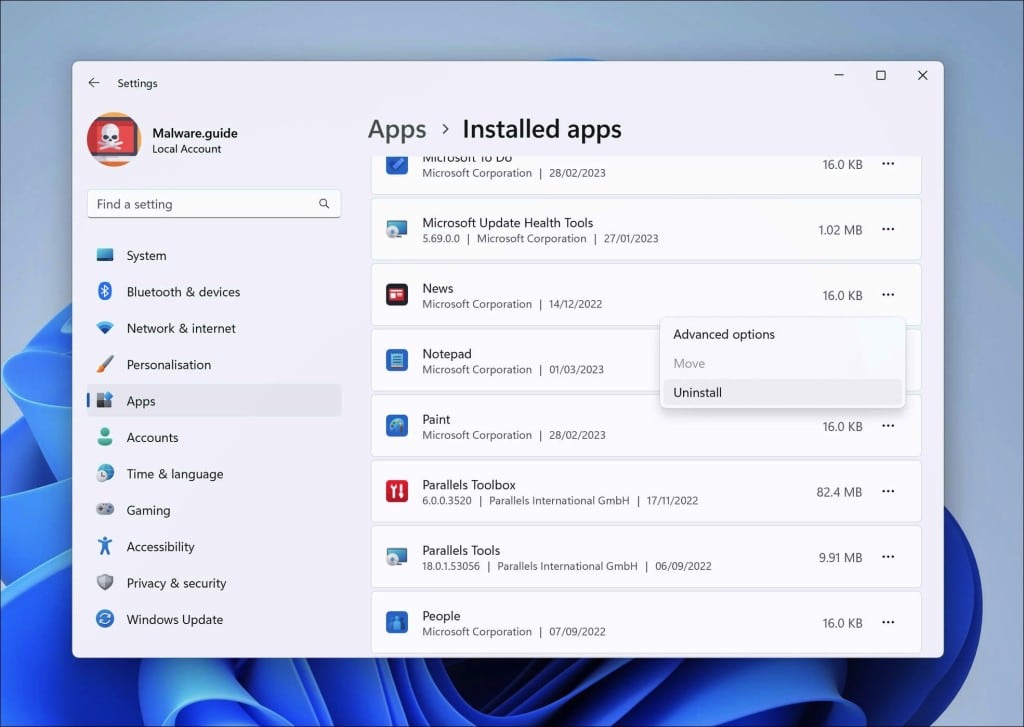
Windows 10
- Click on “Start.”
- Click on “Settings.”
- Click on “Apps.”
- In the list of apps, search for any unknown or unused software.
- Click on the app.
- Lastly, click on the “Uninstall” button.
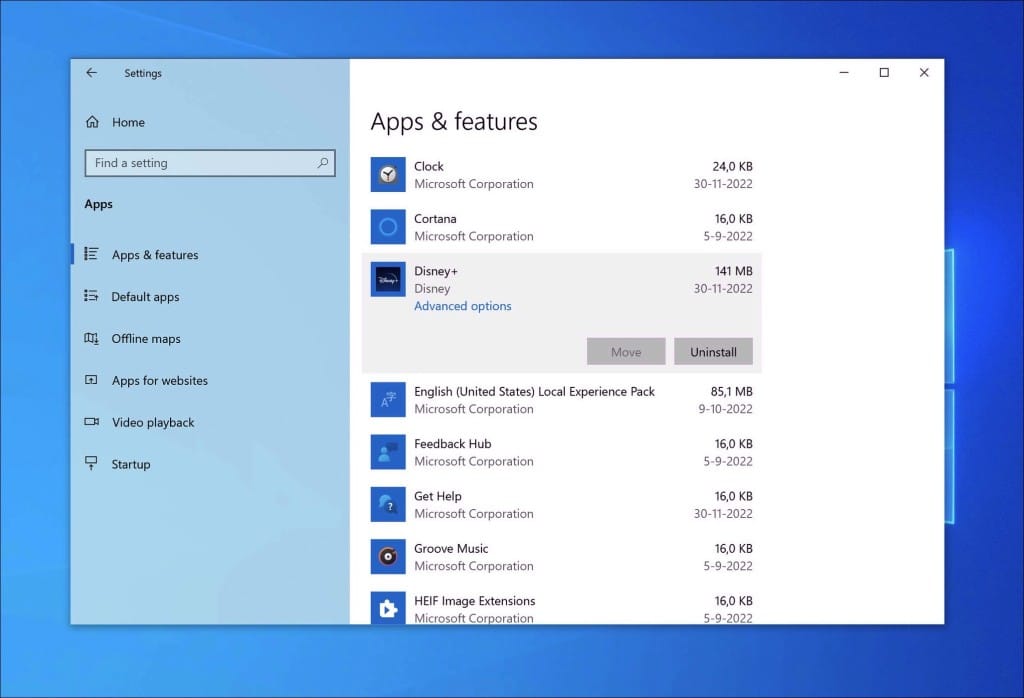
Step 4: Scan your PC for Max Ask
Now that you have uninstalled adware apps, I advise you to check the computer for any other malware for free.
It is not recommended to remove malware manually because it can be difficult for non-technical people to identify and remove all the traces of malware. Manually removing malware involves finding and deleting files, registry entries, and other often hidden details. It can damage your computer or leave it vulnerable to further attacks if not done correctly. So, please install and run the malware removal software, which you can find in this step.
Malwarebytes
Use Malwarebytes to detect adware such as Max Ask and other malware on your computer. The advantage of Malwarebytes is that it is free to detect and remove malware. Malwarebytes is capable of removing different types of malware. In addition to removal, it also offers protection against malware. I recommend using Malwarebytes if only to have checked your computer for malware once.
- Download Malwarebytes
- Install Malwarebytes, and follow the on-screen instructions.
- Click Scan to initiate a malware scan on your PC.
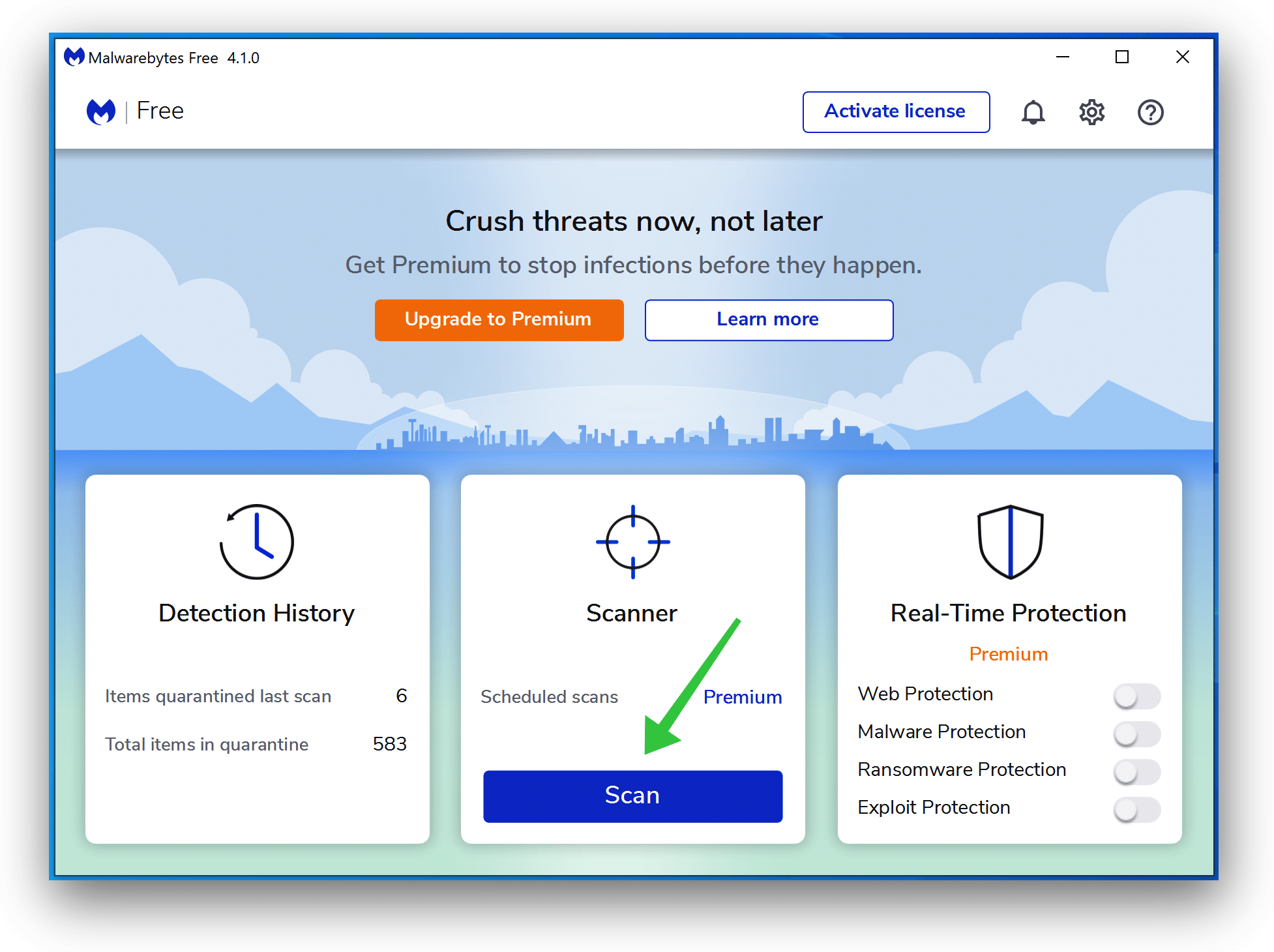
- Wait for the Malwarebytes scan to finish.
- Once completed, review the malware detections.
- Click Quarantine to continue.
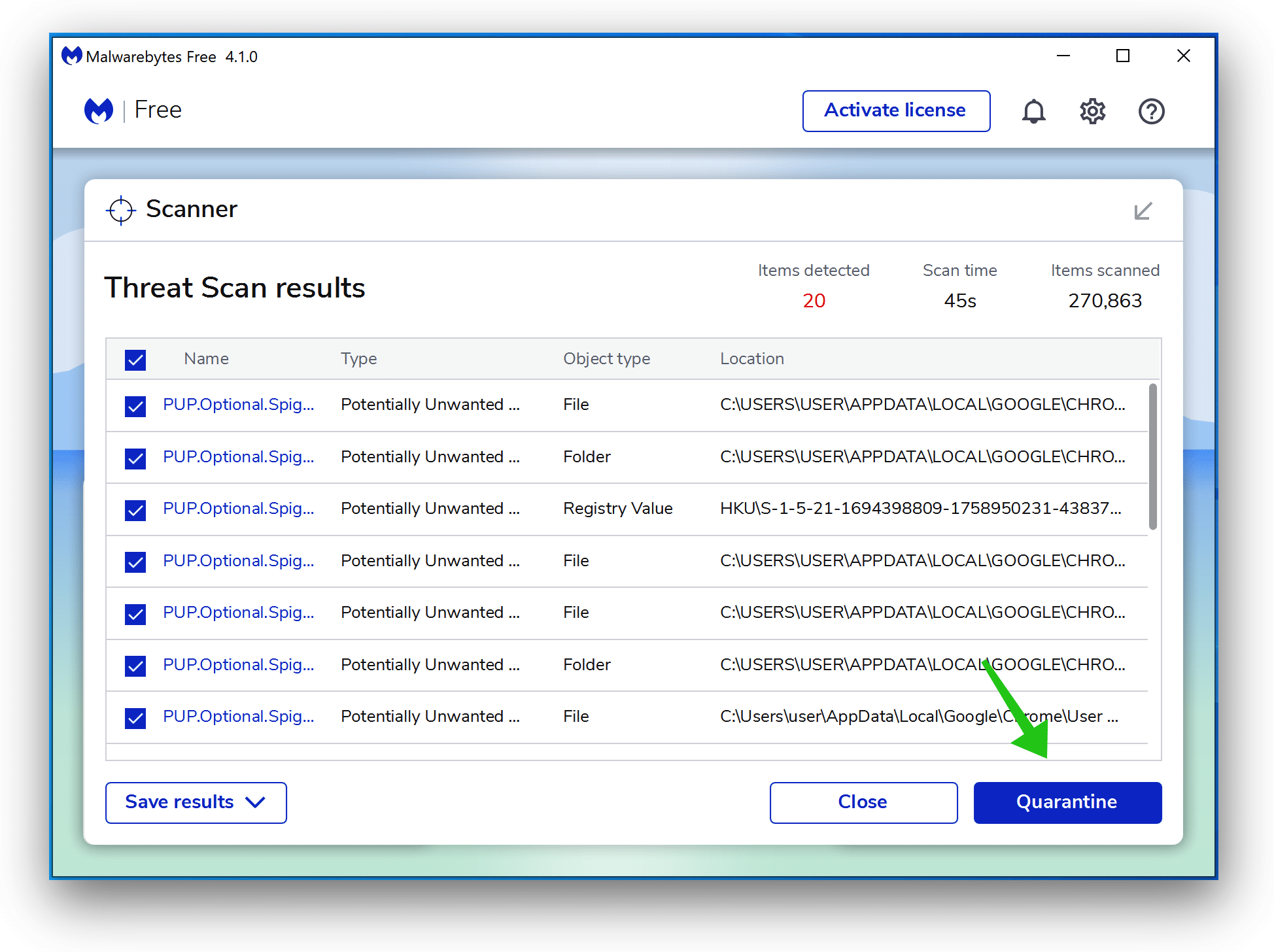
- Reboot Windows after all the malware detections are moved to quarantine.
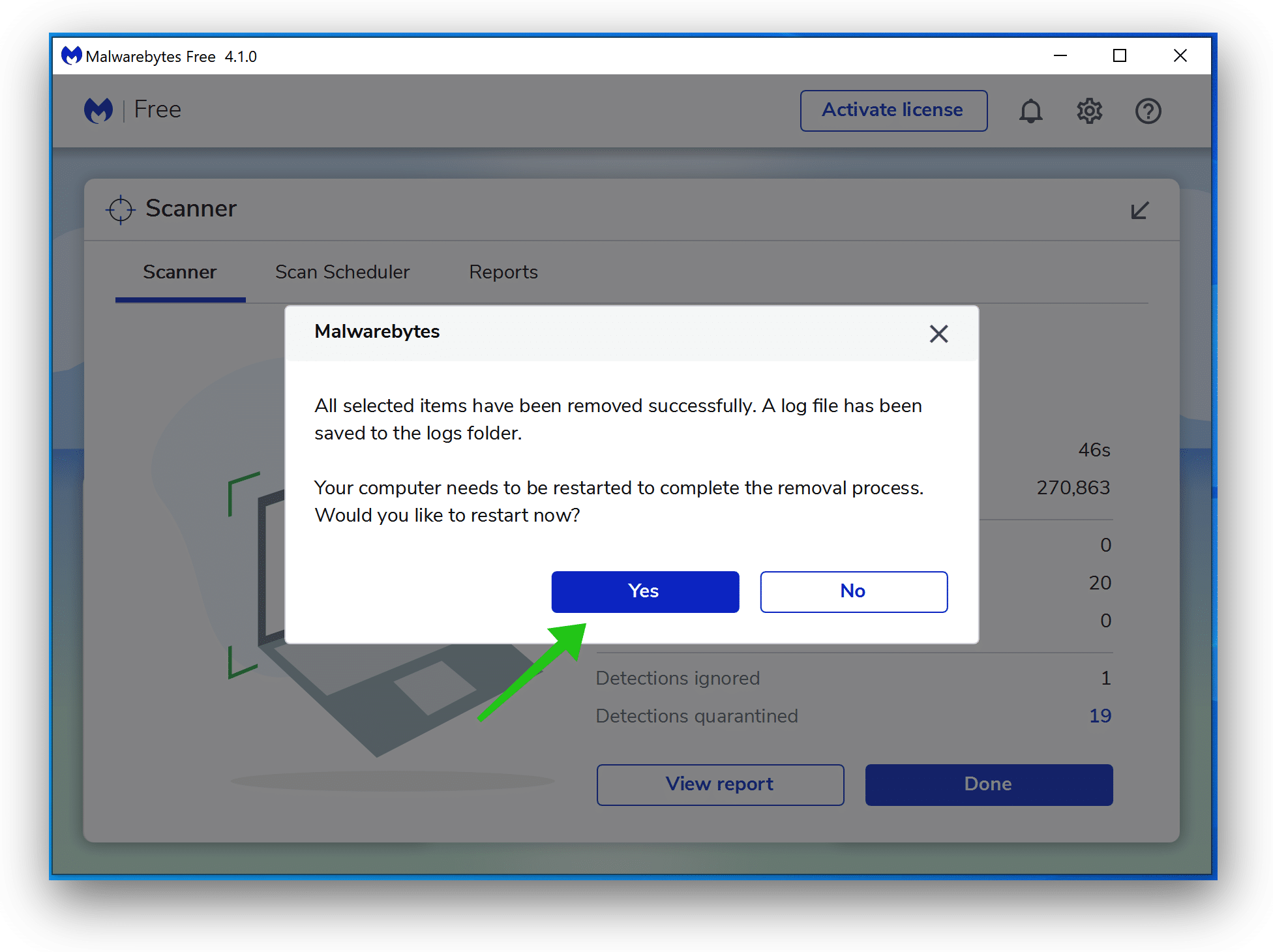
Combo Cleaner
Combo Cleaner is a cleaning and antivirus program for Mac, PC, and Android devices. It is equipped with features to protect devices from various types of malware, including spyware, trojans, ransomware, and adware. The software includes tools for on-demand scans to remove and prevent malware, adware, and ransomware infections. It also offers features like a disk cleaner, big files finder (free), duplicate files finder (free), privacy scanner, and application uninstaller.
Follow the installation instructions to install the application on your device. Open Combo Cleaner after installation.
- Click the "Start scan" button to initiate a malware removal scan.
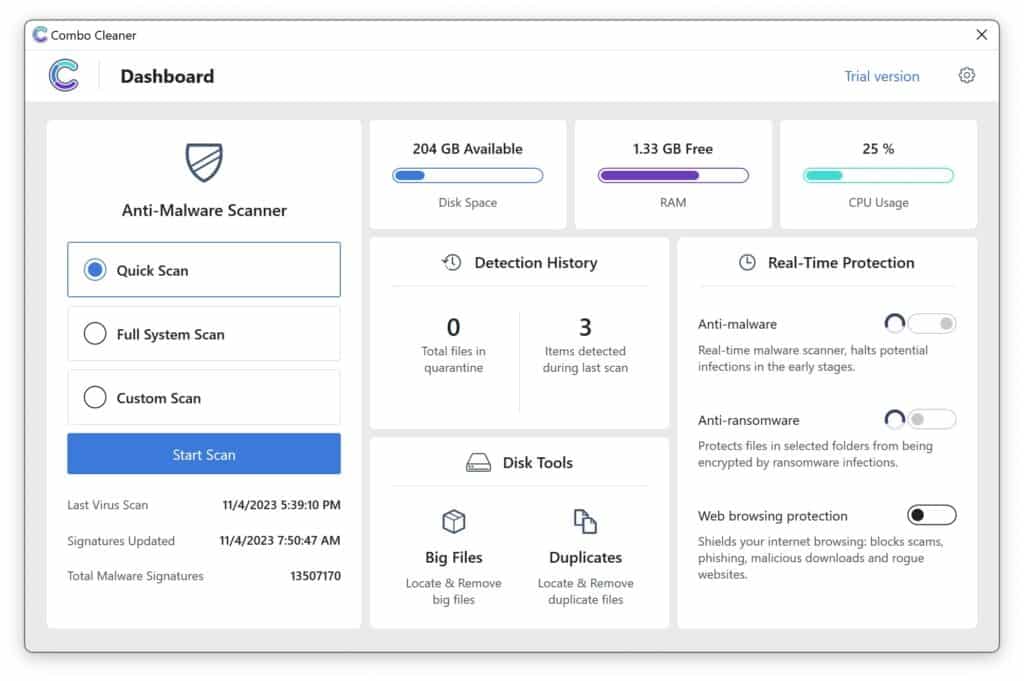
- Wait for Combo Cleaner to detect malware threats on your computer.
- When the Scan is finished, Combo Cleaner will show the found malware.
- Click "Move to Quarantine" to move the found malware to quarantine, where it can't harm your computer anymore.
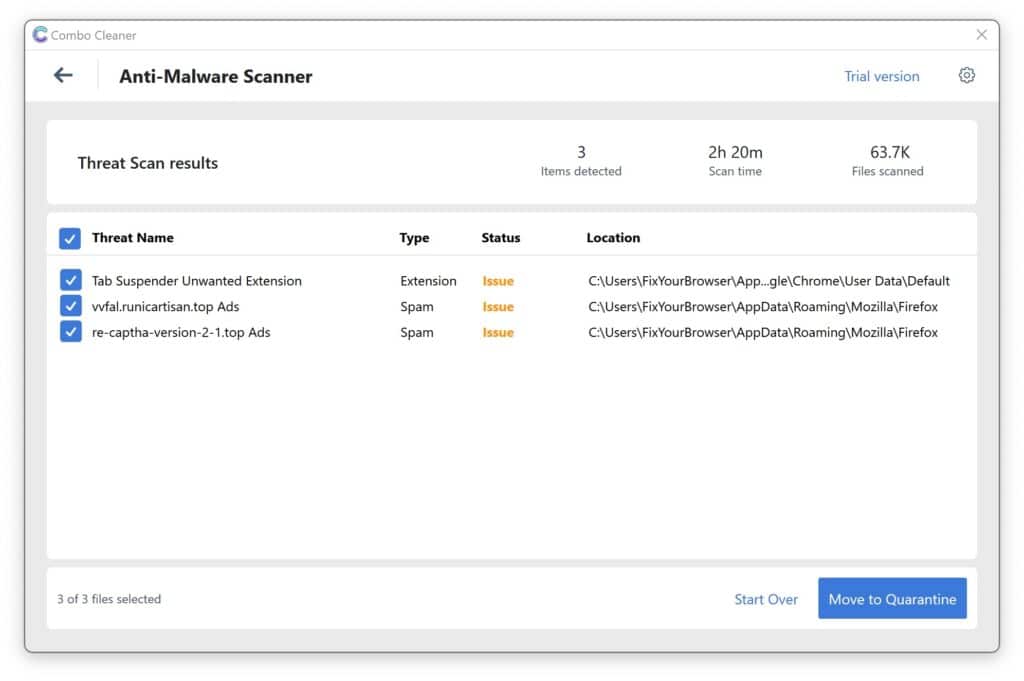
- A malware scan summary is shown to inform you about all threats found.
- Click "Done" to close the scan.
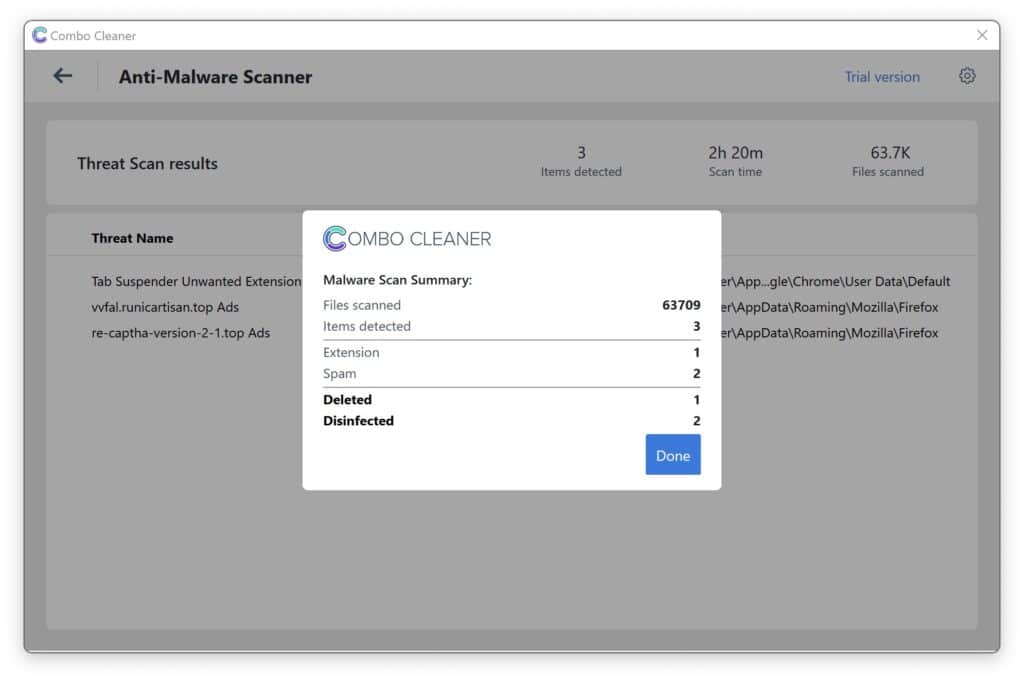
Use Combo Cleaner regularly to keep your device clean and protected. Combo Cleaner will remain active on your computer to protect your computer from future threats that try to attack your computer. If you have any questions or issues, Combo Cleaner offers a dedicated support team available 24/7.
Thank me later 🙂 Please support my work and share this removal instruction with other people. Make sure other people do not become a victim of the Max Ask browser hijacker virus.